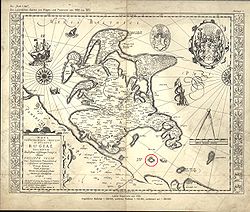Stubber
| Stubber | ||
|---|---|---|
|
Historical map of Rügen (1608) Former island of Stubber marked in red. |
||
| Waters | Greifswalder Bodden ( Baltic Sea ) | |
| Geographical location | 54 ° 13 '53 " N , 13 ° 36' 9" E | |
|
|
||
The Große Stubber is a stony sandbank in the eastern Greifswalder Bodden that dries out at low tide . In the Middle Ages , the stubber was an island that served the lagoon fishermen as a base. By the pliers of stones, the island has been steadily decreasing. In the 19th century, a lot of gravel was extracted there for road construction in Greifswald . As a result, the stubber was first flooded in the first half of the 20th century. The large boulders that are still left today pose a threat to pleasure craft. The stubber is marked with a shoal buoy for shipping . Since 2006 the regatta "Rund Stubber" has been held every year in mid-August.
The name Stubber is derived from Slavic : Stopin stands for level . In 1678 the Stubber Bank served as a collection point for the entire navy for the invasion of Rügen (1678) , which ended with the successful capture of the Swedish-ruled island of Rügen by the Allies Brandenburg-Prussia and Denmark .
The large stubber has been used by the Baltic gray seal (H. g. Balticus) as a resting place since 2004 , after this species had been completely exterminated on the German Baltic coast by 1930. From 2006 onwards, around 7 to 25 gray seals were counted on the Great Stubber all year round.
literature
- Lutz Mohr : Islets built and destroyed on the Baltic coast of the GDR. A historical-geographical view of the islets of whales in the Wismar Bay and Groß-Stubber in the Greifswalder Bodden as evidence of the positive and negative anthropogenic influence in nature. In: Greifswald-Stralsund yearbook . Volume 11. Böhlau-Verlag, Weimar 1977, pp. 17-41.
- Lutz Mohr: Between Danish and Gristower Wiek. The Greifswald suburb of Wieck, the Great Stubber and the Greifswalder Bodden in the past and present. New Greifswald Museum Booklets , No. 4, Greifswald 1978.
- Lutz Mohr: Between Walfisch and Oie. Islets on the Baltic coast of the GDR. In: Yearbook of shipping . Transpress Verlag, Berlin 1986, pp. 109–117, 17 map images.


